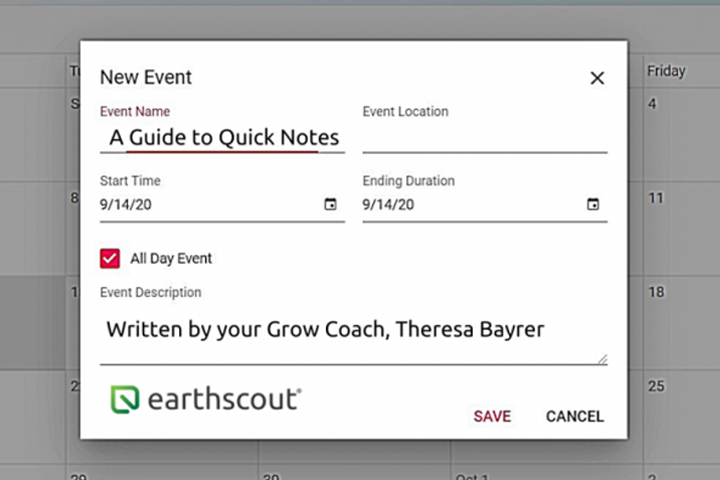I’m Theresa, an EarthScout Grow Coach and Agronomist. My job is to help our customers understand the grow data that they receive from EarthScout and use it to make smart growing decisions regarding irrigation, fertilization, pest management, plant and soil care, and more.
I enjoy taking notes. They make my day to day so much more organized and efficient. So, I suppose you won’t be surprised to hear that one of my favorite features of the EarthScout app is Quick Notes™.
As a Grow Coach, I try to meet with growers every month, and I must take notes all the time in order to keep up with a wide variety of growers and crops each season. Remembering each field, crop, and weather event would be impossible if not for taking good notes!
By December each year, harvests are in and yield tallies are ready for review. That is when the real analysis starts. I sit down with you (grower/consultant) and together we review your data from throughout the season. Analyzing data from EarthScout soil and air sensors combined with yield results helps determine what decisions you want to make next season.
I am most prepared as a coach when I have maintained notes throughout the growing season. Notes are taken during calls with growers, when checking in on how the hardware and software are performing, and after each email is received and sent. I write down every detail I can think of to provide the best customer support possible. Going back through discussion notes leads to learning a lot more from your EarthScout data.
As a grower, did you know that you can conveniently take notes in the EarthScout app? This feature includes the date and time that you make each note (or you can change the date and time to reflect when you first made your observation). Whether you are trying a new fertilizer, changing irrigation scheduling, or trying to figure out why one field yielded better than another, your notes work as a guide. Plus, when you’re on the phone with your EarthScout Grow Coach or local Agronomist, you’ll have the answers to our questions right there at your fingertips.
Recommended opportunities to take notes:
Anytime you place or move an EarthScout. It is common to move your EarthScout around to different parts of a field regularly to adjust the positioning, or to disconnect the soil leads while removing your EarthScout for spray applications. Each time you make an adjustment make note about where your EarthScout is coming from, going to, and why.
Make a note when plants look sick or stressed. If a group of plants or part of a field are growing differently than the rest, this is a great time to take a note and some photos. This creates a record of what you saw that matches with the time and date for the environmental data. Even if you don’t have an EarthScout in that particular field, it can still be useful during diagnosis with a Grow Coach or Agronomist. Note: The EarthScout App will have photo upload functionality in an upcoming version release so you can include photos with your notes.
Note heavy rains and storm conditions. This is especially useful if your EarthScout was placed in a new field or if you have recently tiled, ripped, or switched to no-till practices within the field your EarthScout is in. A part of understanding the water cycle is checking the data against known water events. If you don’t have a logger on your irrigation, make irrigation notes too. It can save a lot of money in irrigated fields very quickly and dryland growers can better adjust cultural practices and applications much easier when you know what your water budget is.
Make the most of your EarthScout data by taking advantage of the Quick Notes feature. If you would like assistance with Quick Notes or advice on how to use EarthScout, please contact an EarthScout Grow Coach today at 877-443-7632.
For more information about how EarthScout can save you time and money, please visit EarthScout.com.
Theresa Bayrer (Lead Grow Coach for EarthScout) is a plant physiologist with over 20 years of experience in professional agronomics.

